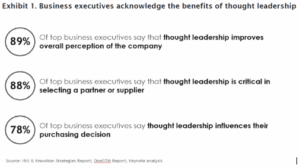By Emmanuel ADU-DARKO, Precious GYAU, & Elizabeth EWUDIWA
Companies are increasingly realizing the crucial role of thought leadership in creating brand value, fostering relationship with clients and driving multi-stakeholder engagement strategies.
While traditionally it was B2B companies who added thought leadership to their toolkit of marketing techniques, more and more B2C companies are investing heavily in thought leadership, riding on the increasing rise in consumer consciousness to rebrand, boost their credibility, and increase their cultural relevance.
This trend towards more thought leadership is only poised to continue as (1) consumers become more knowledgeable and their appetite for “experts” / content creators increase in the age of the influencer (demand side), and equally importantly, (2) executives become more aware of the benefits of thought leadership in shaping overall perception and influencing consumer or buyer behavior and supplier or partner decisions (supply side).

Despite its merits and the growing traction, companies hardly view thought leadership efforts as anything beyond a nice-to-have marketing or stakeholder engagement tactic, with only a fraction of companies achieving anywhere close to their target ROI and only 20% of executives finding their efforts effective, according to a Harris Poll study.
The Status Quo: Why thought leadership fails to achieve target ROI
To maximize the ROI of their spend on thought leadership, companies need to shift from the status quo of events and reports -driven thought leadership that exhibit these characteristics:
- Multiple events and reports to stay relevant but no underlying strategy. Companies are easily trapped into starting their thought leadership efforts with questions like “What events can we launch to engage stakeholders?”, “What reports can we publish to stay relevant in our industry?” This outside-in approach mostly creates square pegs in round holes or band-aid solutions that fail to build lasting value.
- Uncoordinated activities that do not speak to each other. Most companies launch thought leadership efforts across different departments and product lines that result in fragmented messaging and missed opportunities for impact. Without coordination, these efforts fail to reinforce each other leading to no follow-on effect.
- Nice-to-have corporate activities with no clear business impact. If most executives are honest, they conclude rightly that their thought leadership efforts have no bearing on their profitability. Perhaps, that is why they become the lowest hanging fruits in cost saving measures – as the market seeing through their lack of intentionality does not “value” these efforts.
The New Thinking: How to win with thought leadership
To win with thought leadership, companies need a better approach that is grounded in the unrealized value of the company’s unique competencies and internal obsessions. This requires a shift in the following:
From events to strategic imperative. Fundamentally, companies should view thought leadership as an impetus for a strategic move. Thought leadership can and should be used as a vehicle for strategic rebranding, focus on a particular customer segment, and opportunity to drill insights from key market participants to inform a strategic move.
For example, MTN, Africa’s largest telecommunications provider is using well-targeted thought leadership to shift from a telco to a tech company.
Intellectual Property as a Service (IPaaS). Companies should unearth the hidden potential of thought leadership by using it to highlight unique industry-leading competencies and internal obsessions that the market is not pricing into the value of the company.
For example, much to the credit of ex-CEO Paul Polman, Unilever has become a sustainability powerhouse by turning what could have been only an internal obsession to a key value-driver through deliberate thought leadership efforts.
From cost center to revenue driver. Creating the event or publication is the easy part. To maximize ROI, companies need to emphasize throughput.
Strategies to convert audience to paying customers should be at the core of the thought leadership planning effort, forcing teams to measure success based on clear and measurable impact on bottom-line and brand equity.
Research by LinkedIn and Edelman found that about 30% of executives admit that their companies are not adequately using their thought leadership as sales or marketing tool.
From Strategy to Profit: What it takes to deliver effective thought leadership
According to a Harris Poll survey of Fortune 100 executives, the estimated return on investment of thought leadership spend can go as high as 14x. To achieve this, companies need to go beyond strategy and adopt proven, high-value approaches from start to finish.
The Keynote Formula offers a step-by-step guide to developing successful and effective thought leadership that is grounded in business priorities and industry-leading competencies.
The Keynote Formula for developing effective thought leadership
- Assess business priorities & sales goals, and baseline organizational capabilities and core expertise
- Determine highest value thought leadership focus area based on our proprietary Thought Leadership Value (TLV) framework
- Align and finalize topic area with senior leadership in line with business goals.
- Select applicable execution vehicles (for example, executive round-table, forum, webinar, conference, white paper)
- Shortlist key partners and stakeholders (for example, keynote speakers, panelists, international organizations, government agencies, corporate partners, suppliers)
- Initiate cost estimation and budgeting
- Set clear milestones and execute

In today’s influencer-driven world, businesses can no longer afford to compete on products and services alone.
The most successful companies—like Microsoft, Salesforce, and Deloitte—have used thought leadership as a strategic asset to drive revenue, build credibility, and shape industry narratives.
To stay competitive, companies must move beyond thought leadership as a “nice-tohave” and instead treat it as a core pillar of their brand strategy. Those that fail to take a structured, ROI-driven approach risk falling behind in relevance, credibility, and market influence.
The companies that win in the future will not just sell products—they will lead industries through ideas. Now is the time to rethink thought leadership as a business growth engine, not a cost center.
AUTHORS
Emmanuel Adu-Darko
Managing Partner,
Washington DC
Precious Gyau
Partner & Country Director,
Accra
Elizabeth Ewudiwa
Partner, Enterprise Thought Leadership
Accra
ABOUT KEYNOTE ASSOCIATES
Keynote Associates is a thought leadership consulting firm that advises large corporations, governments, and international organizations on end-to-end thought leadership strategy. Beyond advisory, we leverage our network of partners and pre-screened vendors to provide a full-service solution for your company’s thought leadership and strategic stakeholder engagement. Keynote is redefining how companies approach thought leadership, providing them with the advisory, analytical and operational capabilities they need to elevate their brand through strong and well-positioned thought pieces and strategic stakeholder engagement.










